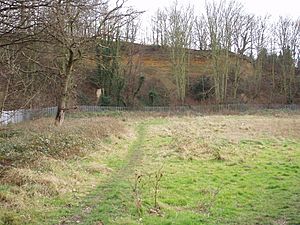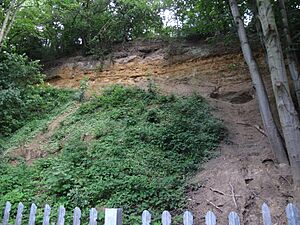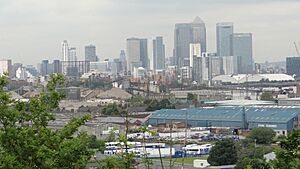Gilbert's Pit facts for kids
| Site of Special Scientific Interest | |
 |
|
| Area of Search | Greater London |
|---|---|
| Interest | Geological |
| Area | 5.2 hectares |
| Notification | 1985 |
| Location map | Magic Map |

Gilbert's Pit is a special place in Charlton, London. It's a 5.2 hectare (about 13 acre) area. It's known for its amazing geology. This means it's a great spot to learn about Earth's history. It's officially called a Site of Special Scientific Interest. This protects its unique features.
It was named a special site in 1985. Before that, it was known as Charlton Sand Pit. Gilbert's Pit is also part of a bigger area. This area is called the Maryon Wilson Park and Gilbert's Pit Local Nature Reserve. It sits right next to Maryon Park and is close to Maryon Wilson Park.
Contents
History of Gilbert's Pit
People have lived in this area for a very long time. On top of Gilbert's Pit is a hill called Cox's Mount. A Roman-British settlement was here. People lived on Cox's Mount from the first to the fifth centuries.
The area was once part of an old forest. This forest was known as Hanging Wood. Gilbert's Pit itself was part of the Maryon-Wilson family's land. From the late 1700s until 1889, people dug for sand here. The pit was named after one of its managers, Mr. E. Gilbert. The London County Council bought the land in 1930.
Discovering Ancient Earth: Geology at Gilbert's Pit
Gilbert's Pit is a very important place for geology. It shows one of the most complete sets of rock layers in Greater London. These layers tell us about Earth's past. The rocks here are from a time called the Paleogene period. This was about 55 million years ago.
You can see layers from the Thanet Formation and the Woolwich Formation. These layers are like pages in a history book. They show how the land changed over millions of years. Some of these rock beds hold many fossils. Scientists have found ancient plants, sponges, and shells. They have also found fish and reptile fossils here. People have been studying this site for over 120 years. It has been written about in many science books.
Nature and Wildlife at Gilbert's Pit
The sides of Gilbert's Pit are very steep. This creates different habitats for plants and animals. The main trees you will see are birch and oak. On the higher, sunny slopes, you can find yellow gorse and broom plants.
Lower down, there are hawthorn bushes. These bushes are great places for birds to build their nests. They offer good shelter and food for many bird species.
Visiting Gilbert's Pit
Most of Gilbert's Pit is fenced off to protect it. But some parts are open for visitors. You can get into the open area from Charlton Lane. There is also a path from Maryon Park. Look for the Gilbert's Pit information board in Maryon Park. This path leads up to Cox's Mount. From Cox's Mount, you can enjoy amazing views over London.


